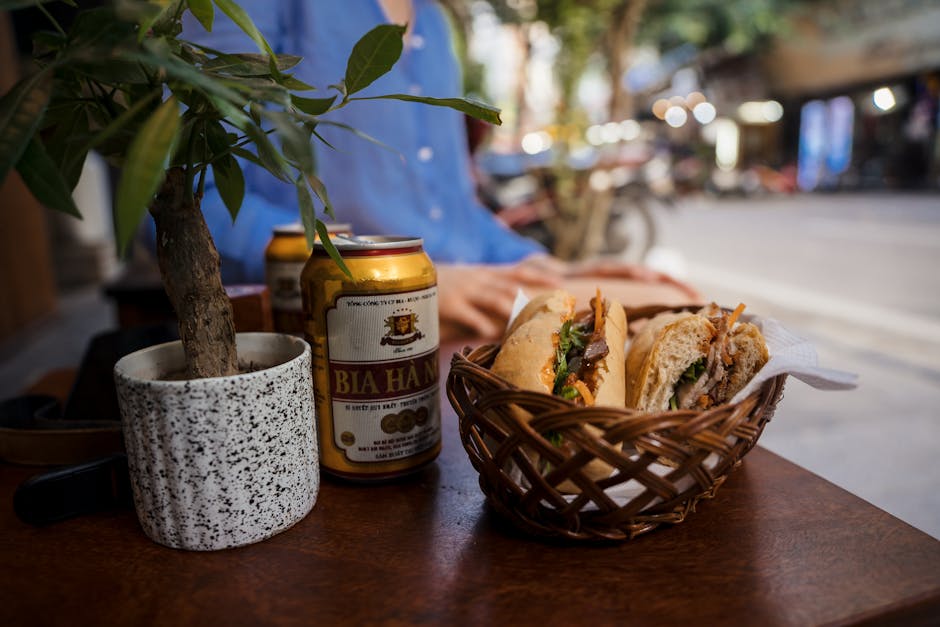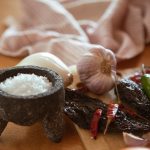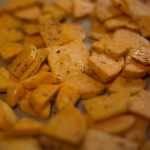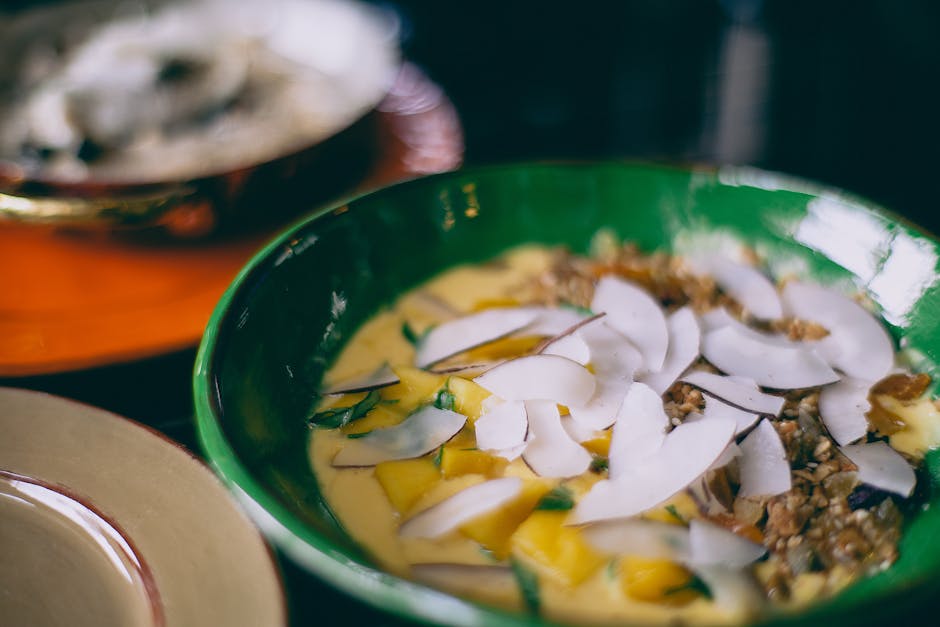Journey with us to the vibrant streets of Vietnam, where the aroma of freshly baked bread mingles with the fragrant symphony of pickled vegetables, savory meats, and pungent herbs. We’re talking about the Banh Mi, a culinary masterpiece that transcends its humble beginnings to become a global sensation. More than just a sandwich, Banh Mi is a testament to Vietnam’s rich culinary heritage and its ability to adapt and innovate.
The story of Banh Mi begins in the early 20th century, a period marked by French colonial rule in Vietnam. The baguette, a staple of French cuisine, found fertile ground in Vietnamese soil, adapting and evolving to become a cornerstone of Vietnamese street food. While the exact origins are debated, the fusion of French bread-making techniques with traditional Vietnamese ingredients and flavors birthed this iconic sandwich. It’s a fascinating example of culinary cross-pollination, where two distinct cultures intertwined to create something entirely new and uniquely delicious.
The post-war era saw Banh Mi become a symbol of resilience and resourcefulness. In a nation rebuilding itself after conflict, the relatively inexpensive and readily available ingredients—from leftover meats to a variety of fresh vegetables—made Banh Mi a popular and accessible meal for all. Its adaptable nature allowed for countless variations, reflecting regional differences and individual preferences. This adaptability, combined with its deliciousness and affordability, propelled it to become a daily staple for millions of Vietnamese people.
Today, Banh Mi’s popularity extends far beyond Vietnam’s borders. It is estimated that millions of Banh Mi are sold globally each day, with dedicated shops popping up in major cities worldwide. This global phenomenon is a testament to its unique flavor profile, combining the satisfying crunch of the bread with the savory, sweet, sour, and spicy elements of its diverse fillings. From the classic combination of pâté, pickled carrots and daikon, cilantro, and jalapeños, to more modern variations incorporating everything from grilled pork to tofu and even egg, the Banh Mi offers endless possibilities for culinary exploration.
Beyond its deliciousness, Banh Mi holds significant cultural importance. It represents a fusion of cultures, a testament to Vietnam’s resilience, and a symbol of its vibrant street food culture. More than just a quick lunch, it’s a culinary experience that reflects the nation’s history, its ingenuity, and its enduring spirit. This is why we’re so excited to share with you the best Banh Mi experience possible, one that captures the essence of this iconic sandwich and its rich story.
Ingredients and Measurements: Best Vietnamese Banh Mi
Crafting the perfect Banh Mi requires careful attention to ingredient quality and precise measurements. This recipe yields approximately 4 delicious sandwiches.
For the Bread (Banh Mi):
- 1 cup (240ml) lukewarm water (around 105-115°F)
- 1 teaspoon (4g) granulated sugar
- 2 teaspoons (4g) active dry yeast
- 1 teaspoon (5ml) vegetable oil
- 3 cups (360g) bread flour, plus more for dusting
- 1 teaspoon (5g) salt
Important Note: Using lukewarm water is crucial for activating the yeast. Too hot, and you’ll kill it; too cold, and it won’t activate properly. Bread flour is recommended for its higher protein content, resulting in a chewier, more substantial bread. You can substitute all-purpose flour, but the texture will be slightly different.
For the Filling:
- Protein: 8 ounces (225g) thinly sliced grilled pork belly (thịt ba chỉ) or thinly sliced marinated lemongrass pork (thịt heo nướng sả) – ensure the meat is cooked through before slicing.
- Pickled Vegetables: 1 cup (100g) julienned carrots and daikon radish, pickled in a mixture of 1/2 cup (120ml) rice vinegar, 1/4 cup (60ml) water, 2 tablespoons (30g) sugar, 1 tablespoon (15ml) salt, and 1 tablespoon (15ml) of your choice of pickling spices (coriander seeds, black peppercorns, etc.). Allow to pickle for at least 30 minutes for optimal flavor.
- Fresh Herbs: 1/2 cup (15g) chopped cilantro, 1/4 cup (10g) chopped Thai basil, a small handful of mint leaves (approximately 10g).
- Condiments: 1/4 cup (60ml) mayonnaise, 2 tablespoons (30ml) sriracha or your preferred chili sauce. Adjust the amount of sriracha according to your spice preference.
- Other Ingredients: 1/4 cup (30g) thinly sliced cucumber, 1/4 cup (20g) thinly sliced jalapeño peppers (optional), 1 tablespoon (15g) butter, softened.
Professional Recommendation: For the best flavor, prepare your pickled vegetables and marinades a day ahead of time. This allows the flavors to fully develop and meld.
Measurement Notes: All measurements are approximate. Feel free to adjust quantities to your liking, particularly regarding the spice level. For example, if you prefer a less spicy Banh Mi, reduce the amount of jalapeños and sriracha. If you want a richer flavor, increase the amount of herbs.
Important: The success of your Banh Mi hinges on using high-quality ingredients. Fresh, flavorful herbs and properly pickled vegetables are essential for achieving an authentic and delicious taste.
Equipment List: Crafting the Perfect Banh Mi
Creating authentic and delicious Vietnamese Banh Mi requires the right tools. While some items are essential, others offer significant advantages in efficiency and quality. This equipment list categorizes tools by necessity and provides recommendations for optimal results.
Essential Equipment:
1. Sharp Knives: At least two are crucial. A large chef’s knife (8-10 inches) is needed for chopping vegetables like carrots, daikon, and cilantro. A smaller paring knife (3-4 inches) is essential for detailed work such as slicing pickled carrots and daikon, and preparing smaller ingredients like jalapeños. Invest in high-quality knives and keep them sharp; dull knives are dangerous and inefficient. Consider a honing steel for regular maintenance between sharpenings.
2. Cutting Board: A large, sturdy cutting board (at least 12×16 inches) is necessary to accommodate all your chopping needs. Choose a material that’s easy to clean and sanitize, such as plastic or wood (properly treated). Having multiple cutting boards – one for raw meats and one for vegetables – is recommended for food safety.
3. Mixing Bowls: You’ll need several mixing bowls of varying sizes (small, medium, and large) for preparing different components of the Banh Mi. Stainless steel bowls are durable and easy to clean. A good set of measuring cups and spoons is also essential for accurate ingredient measurements.
4. Baking Sheet and Parchment Paper: If you are baking your own bread rolls, you will need a baking sheet to place the dough on. Using parchment paper prevents sticking and makes cleanup much easier. Alternatively, you can use a baking stone for crispier rolls.
Recommended Equipment (for enhanced results):
1. Food Processor: While not strictly necessary, a food processor significantly speeds up the preparation of ingredients like the pickled vegetables. It can quickly shred carrots and daikon, ensuring even and consistent sizes. A food processor also aids in making mayonnaise-based sauces smoother.
2. Meat Slicer (optional): For perfectly thin slices of meat, a meat slicer is highly recommended. It ensures uniform thickness and improves the overall texture of the Banh Mi. If you don’t have one, a very sharp knife and steady hand can achieve similar results, but it will take more time and effort.
3. Grill Pan or Skillet: For those wanting to grill or sear their meat, a grill pan or heavy-bottomed skillet is ideal. A grill pan provides characteristic grill marks, enhancing the visual appeal and adding a smoky flavor. A cast iron skillet works wonderfully for even heat distribution.
4. Oven Thermometer: Accurate oven temperature is crucial for baking the Banh Mi rolls. An oven thermometer ensures your oven is at the correct temperature, preventing undercooked or overcooked bread. This is particularly important for consistent results.
5. Large Storage Containers: You’ll need airtight containers to store the prepared components of your Banh Mi, such as pickled vegetables, pate, and cooked meats. Proper storage ensures freshness and extends the lifespan of your ingredients.
Meat Marinade Preparation (if applicable)
While many Banh Mi variations utilize pre-cooked meats like grilled pork (thịt nướng) or cold cuts, achieving truly authentic and flavorful results often involves marinating the meat beforehand. This section details the preparation of a classic marinade for grilled pork, perfect for your Banh Mi. Adjusting the quantities is straightforward based on the amount of meat you’re preparing.
For this recipe, we’ll assume you’re using approximately 1 lb (450g) of pork shoulder, cut into 1-inch thick slices. This cut provides excellent flavor and tenderness after grilling. If using a different cut, like pork loin, adjust the marinating time accordingly; leaner cuts may require less time to prevent over-drying.
Ingredients for the Pork Marinade:
- 1 lb (450g) pork shoulder, cut into 1-inch thick slices
- 1/4 cup (60ml) fish sauce – Use a high-quality fish sauce for the best flavor.
- 2 tablespoons (30ml) soy sauce – A darker soy sauce will add a richer color.
- 2 tablespoons (30ml) rice vinegar – This balances the saltiness and adds brightness.
- 2 tablespoons (30g) brown sugar – Provides sweetness and helps caramelize during grilling.
- 2 cloves garlic, minced – Essential for aromatic depth.
- 1 tablespoon (15ml) grated ginger – Adds warmth and complexity.
- 1 teaspoon black pepper – Enhances the savory notes.
- 1/2 teaspoon five-spice powder (optional) – Adds a subtle layer of warmth and spice.
Instructions:
- In a large bowl, whisk together the fish sauce, soy sauce, rice vinegar, brown sugar, minced garlic, grated ginger, black pepper, and five-spice powder (if using) until the sugar is dissolved. Ensure all ingredients are well combined for even flavor distribution.
- Add the pork slices to the marinade, ensuring they are fully coated. Use tongs or your hands to gently massage the marinade into the meat.
- Cover the bowl with plastic wrap and refrigerate for at least 4 hours, or preferably overnight. The longer the meat marinates, the more flavorful it will become. However, marinating for more than 24 hours may result in overly salty or tender meat.
- Before grilling, remove the pork from the marinade and discard the excess marinade. Do not grill the pork directly in the marinade, as this can cause flare-ups and potentially char the meat unevenly.
- Grill the pork over medium heat until cooked through and slightly charred, about 4-6 minutes per side, or until the internal temperature reaches 145°F (63°C). Adjust grilling time based on the thickness of your pork slices.
Important Note: Always ensure your meat is cooked to a safe internal temperature to prevent foodborne illness. Use a meat thermometer to check the temperature before serving.
This marinade can also be adapted for other meats, such as chicken or beef. Remember to adjust the marinating time depending on the type and cut of meat you are using. Experiment with different spice combinations to find your perfect Banh Mi flavor profile!
Vegetable Preparation for the Best Vietnamese Banh Mi
The vibrant freshness of the vegetables is crucial to a truly exceptional Banh Mi. Proper preparation ensures optimal texture and flavor, complementing the rich pâté and savory meats. Don’t rush this stage; meticulous attention to detail will elevate your sandwich to the next level.
Carrot & Daikon Pickles (Do Chua): This is arguably the most important element of the Banh Mi’s vegetable component. For a batch sufficient for several sandwiches, you’ll need:
- 1 large carrot, peeled and julienned into thin matchsticks (approximately 1 cup)
- 1 large daikon radish, peeled and julienned into thin matchsticks (approximately 2 cups)
- 1/2 cup white vinegar (rice vinegar is preferred)
- 1/4 cup sugar
- 2 tablespoons salt
- 1 tablespoon water
Combine the julienned carrots and daikon in a large bowl. Generously sprinkle with salt and gently massage the vegetables for a few minutes. This draws out excess moisture and helps them to become more tender and receptive to the pickling liquid. Let the mixture sit for at least 30 minutes, or even better, an hour. This process helps to soften the vegetables and develop a pleasant crunch.
After the waiting period, rinse the vegetables thoroughly under cold water to remove excess salt. Squeeze out as much water as possible using your hands or a clean kitchen towel; this is crucial for preventing a watery sandwich. In a separate saucepan, combine the vinegar, sugar, and water. Bring to a simmer over medium heat, stirring until the sugar dissolves completely. Pour this hot pickling liquid over the carrots and daikon. Let it cool completely before storing in an airtight container in the refrigerator. The longer they pickle, the better the flavor, but they’ll be ready to use after at least 4 hours.
Cilantro & Mint: Fresh herbs are essential. Use about 1/4 cup of tightly packed cilantro leaves and 1/4 cup of tightly packed mint leaves per sandwich. Wash the herbs thoroughly and gently pat them dry. Roughly chop them before adding to your Banh Mi. Avoid over-chopping, as you want to retain some texture.
Jalapeños (optional): For those who enjoy a little heat, thinly sliced jalapeños add a fantastic kick. Use about 1/2 to 1 jalapeño, depending on your spice preference. Remove the seeds and membranes for less heat.
Cucumber: Thinly sliced English cucumbers or regular cucumbers add a refreshing crunch. About 1/4 of a cucumber, thinly sliced, per sandwich is perfect. Pat them dry to avoid excess moisture.
Preparation Tips for Optimal Results:
- Use a mandoline slicer for perfectly even and thin julienned carrots and daikon for consistent pickling.
- Don’t skip the salting and rinsing step for the pickles; this is key to their texture and flavor.
- Prepare the vegetables ahead of time; the pickled carrots and daikon improve in flavor over time.
- Store the prepared vegetables separately in airtight containers in the refrigerator to maintain freshness.
By following these detailed steps, you’ll ensure that the vegetable component of your Banh Mi is as flavorful and texturally delightful as possible, creating a truly unforgettable culinary experience.
Bread Preparation/Sourcing
The banh mi baguette is arguably the most crucial component of this beloved sandwich. Its crisp crust and airy interior are essential for the perfect textural contrast with the fillings. While sourcing a pre-made baguette from a reputable Asian bakery is a viable option, especially for beginners, making your own offers unparalleled control over flavor and texture. For the best results, aim for a baguette with a thin, crackling crust and a soft, slightly chewy crumb.
Sourcing Pre-Made Baguettes: If opting for pre-made baguettes, seek out bakeries specializing in Vietnamese bread. Look for baguettes with a golden-brown crust, a slightly elongated shape, and a noticeable crispness. Avoid baguettes that are overly soft or pale in color. Purchase them fresh on the day of serving for optimal texture and flavor. Consider purchasing slightly more than needed to account for any breakages during handling.
Homemade Baguette Recipe (Yields approximately 8 baguettes):
- Ingredients:
- 500g strong bread flour (12% protein or higher)
- 325g lukewarm water (approximately 100-110°F)
- 10g salt
- 5g instant dry yeast (or 15g fresh yeast)
- 1 tbsp sugar (optional, enhances yeast activity)
Instructions:
- In a large bowl, combine the lukewarm water, sugar (if using), and yeast. Let stand for 5-10 minutes until foamy. This activates the yeast.
- Add the flour and salt to the yeast mixture. Mix with a wooden spoon or your hands until a shaggy dough forms.
- Knead the dough for 8-10 minutes, either by hand on a lightly floured surface or using a stand mixer with a dough hook. The dough should become smooth and elastic.
- Place the dough in a lightly oiled bowl, turning to coat. Cover with plastic wrap and let rise in a warm place for 1-1.5 hours, or until doubled in size.
- Gently punch down the dough and divide it into 8 equal pieces. Shape each piece into a long baguette shape (approximately 12-14 inches long).
- Place the shaped baguettes onto a baking sheet lined with parchment paper. Cover loosely with plastic wrap and let rise for another 30-45 minutes.
- Preheat your oven to 450°F (232°C) with a baking stone or baking sheet inside for at least 30 minutes. This is crucial for a crisp crust.
- Before baking, lightly spray the baguettes with water for a glossy crust. You can also score the baguettes with a sharp knife or lame for a more aesthetic and even bake.
- Bake for 20-25 minutes, or until golden brown and the internal temperature reaches 200-210°F (93-99°C).
- Let the baguettes cool completely on a wire rack before slicing and serving.
Important Considerations: Proper hydration and kneading are critical for the baguette’s texture. Under-kneaded dough will result in a dense baguette, while over-kneaded dough will be tough. Using high-protein flour is essential for achieving a good gluten development, resulting in a chewy crumb. A hot oven and a preheated baking stone will contribute significantly to the crust’s crispness.
Regardless of whether you source pre-made or make your own, ensure the bread is fresh and at room temperature before filling your banh mi to prevent sogginess.
Pickling Vegetables for the Best Banh Mi
The vibrant, tangy crunch of pickled vegetables is absolutely essential to a truly authentic and delicious Vietnamese Banh Mi. Mastering this technique elevates your sandwich from good to unforgettable. This section details how to pickle carrots and daikon radish, the most common accompaniments, but feel free to experiment with other vegetables like cucumbers or jalapeños.
Choosing your vegetables: Select firm, fresh carrots and daikon radish. Avoid any that are bruised or soft. For optimal results, use approximately 1 pound of carrots and 1 pound of daikon radish. Peel the carrots and use a vegetable peeler to create long, thin matchsticks, aiming for approximately 1/8 inch thickness. Do the same with the daikon, ensuring consistent size for even pickling.
Preparing the pickling brine: The brine is the heart of the pickling process. Precise measurements are key to achieving the perfect balance of sweet, sour, and salty. In a medium saucepan, combine the following ingredients:
- 1 cup white vinegar (distilled or rice vinegar works best)
- 1/2 cup granulated sugar
- 2 tablespoons kosher salt (adjust to taste, less for a milder pickle)
- 1/2 teaspoon black peppercorns
- 2-3 cloves garlic, smashed
- 1-2 small red chilies, thinly sliced (optional, for added heat)
Combining and pickling: Bring the brine to a boil over medium heat, stirring until the sugar and salt are completely dissolved. Remove from heat and let cool completely to room temperature. This is crucial to prevent the vegetables from becoming mushy. Once cooled, add the carrot and daikon matchsticks to a clean, sterilized glass jar. Pour the cooled brine over the vegetables, ensuring they are fully submerged. Use a clean weight, such as a small jar filled with water, to keep the vegetables submerged in the brine. This prevents discoloration and ensures even pickling.
Fermentation and storage: Cover the jar with a lid and refrigerate for at least 4 hours, or preferably overnight. The longer they pickle, the more intense the flavor will become. However, don’t leave them for more than 3-4 days in the fridge, as this could lead to unwanted fermentation and softening. After the pickling time, taste test and adjust seasonings if necessary. The pickled vegetables will keep in the refrigerator for up to 2 weeks.
Professional recommendations: For a more visually appealing result, try to create uniformly sized matchsticks. Using a mandoline slicer can ensure consistency. If you prefer a less spicy pickle, reduce or omit the chili peppers. Experiment with the sugar and salt ratios to adjust the sweetness and saltiness to your personal preference. Remember, the freshest ingredients will always yield the best results, so choose your vegetables carefully.
Enjoy! Once your pickled carrots and daikon are ready, add them generously to your Banh Mi for a truly authentic and delicious flavor experience.
Best Vietnamese Banh Mi: Recommendations
Our Best Vietnamese Banh Mi is a culinary masterpiece, expertly crafted with the freshest ingredients and traditional techniques. To fully appreciate its deliciousness, we recommend the following:
Serving Suggestions: For the ultimate Banh Mi experience, enjoy it immediately after preparation. The bread’s crispiness and the fillings’ freshness are best experienced when the sandwich is warm and the flavors haven’t had time to separate. Gently squeeze the sandwich to allow all the flavors to meld together before taking a bite. Avoid cutting it in half unless absolutely necessary, as this can lead to filling spillage and a less satisfying eating experience. Enjoy it standing up or seated, as the sandwich is best enjoyed handheld.
Storage Conditions: While we strongly advise enjoying your Banh Mi fresh, if leftovers remain, store them properly to preserve their quality. Wrap the Banh Mi tightly in plastic wrap or foil to prevent it from drying out. Refrigerate for up to 24 hours. Do not freeze, as this will significantly compromise the texture of the bread and the overall taste. Reheating is not recommended, as it will likely make the bread soggy.
Complementary Dishes: To enhance your Banh Mi experience, consider these delicious pairings: A refreshing Vietnamese iced coffee (Cà phê sữa đá) cuts through the richness of the sandwich beautifully. A light and tangy Vietnamese summer roll (Gỏi cuốn) offers a refreshing contrast in texture and flavor. For a heartier accompaniment, a small bowl of dưa leo (pickled carrots and daikon radish) adds a delightful crunch and acidity. A simple green salad with a light vinaigrette can also be a very pleasant addition.
Nutritional Information (Approximate per serving): The nutritional content of our Banh Mi can vary slightly depending on the specific ingredients used. However, a typical serving (approximately 250g) contains roughly: Calories: 450-550; Protein: 20-25g; Fat: 20-25g; Carbohydrates: 50-60g; Fiber: 5-7g. These are estimates and may not be entirely accurate. For precise nutritional information, please consult a registered dietitian or refer to the detailed ingredient list.
Important Note on Ingredients: Our Banh Mi is made with high-quality, fresh ingredients. We use locally sourced produce whenever possible. We are happy to accommodate dietary restrictions and allergies. Please inform us of any allergies or special dietary requirements when placing your order. We will do our best to accommodate your needs, but some substitutions may affect the overall taste and nutritional information.
Enjoy your Best Vietnamese Banh Mi! We hope you savor every delicious bite and appreciate the care and craftsmanship that went into creating this exceptional sandwich. We value your feedback and encourage you to share your experience with us.





